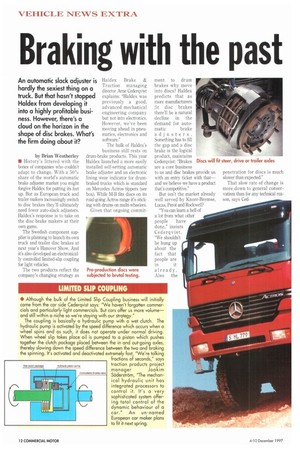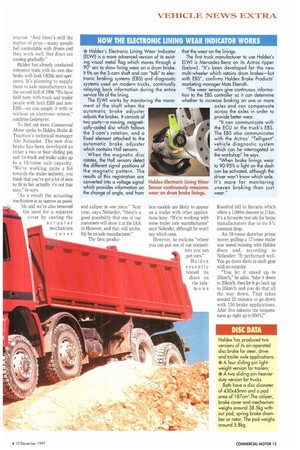Braking with the past
Page 14

Page 15

If you've noticed an error in this article please click here to report it so we can fix it.
An automatic slack adjuster is hardly the sexiest thing on a truck. But that hasn't stopped Haldex from developing it into a highly profitable business. However, there's a
cloud on the horizon in the shape of disc brakes. What's the firm doing about it?
by Brian Weatherley • History's littered with the bones of companies who couldn't adapt to change. With a 50% share of the world's automatic brake adjuster market you might forgive Haldex for putting its feet up. But as European truck and trailer makers increasingly switch to disc brakes they'll ultimately need fewer auto-slack adjusters. Haldex's response is to take on the disc brake makers at their own game.
The Swedish component supplier is planning to launch its own truck and trailer disc brakes at next year's Hanover Show. And it's also developed an electronically controlled limited-slip coupling for light vehicles.
The two products reflect the company's changing strategy as Haldex Brake & Traction managing director Arne Cederqvist explains: "Haldex was previously a good, advanced mechanical engineering company but not into electronics. However, we've been moving ahead in pneumatics, electronics and software."
The bulk of Haldex's business still rests on drum-brake products. This year Haldex launched a more easily installed self-setting automatic brake adjuster and an electronic lining wear indicator for drumbraked trucks which is standard on Mercedes Actros tippers (see box). While M-B fits discs on its road-going Actros range it's sticking with drums on multi-wheelers.
Given that ongoing commit ment to drum brakes why move into discs? Haldex predicts that as more manufacturers fit disc brakes there'll be a natural decline in the demand for auto matic brake adjusters. Something has to fill the gap and a disc brake is the logical product, maintains Cederqvist: "Brakes are a core business to us and disc brakes provide us with an entry ticket with that— and we believe we have a product that's competitive."
But isn't the market already well served by Knorr-Bremse, Lucas, Perot and Rockwell?
"You can learn a hell of a lot from what other people have done," insists Cederqvist. "We shouldn't be hung up about the fact that people are in it already. Also the penetration for discs is much slower than expected."
That slow rate of change is more down to general conservatism than for any technical reason, says Ced erqvist. "And there's still the matter of price—many people feel comfortable with drums and they work well. But discs are coming gradually."
Haldex has already conducted extensive trials with its own disc brake with both OEMs and operators. It's planning to supply them to axle manufacturers by the second half of 1998. "We have field tests with truck and trailer people with both EBS and nonEBS—we can supply it with or without an electronic sensor," confirms Cederqvist.
To find out more, GAnmercial Motor spoke to Haldex Brake & Traction's technical manager Ake Nelander. The new disc brake has been developed as either a two or four sliding pin unit for truck and trailer wdes up to a 13-tonne axle capacity. "We're working quite a bit towards the trailer industry, you think that you've got a lot of area to fit in but actually it's not that easy," he says.
"As a result the actuating mechanism is as narrow as possible and we've also removed the need for a separate cover by casting the actuator mechanism cover and caliper in one piece." Next year, says Nelander, "there's a good passibility that one of our customers will show it at the IAA in Hanover, and that will probably be an axle manufacturer."
The first produc
tion models are likely to appear on a trailer with other applications later. "We're working with some trailer axle manufacturers" says Nelander, although he won't say which ones.
However, he reckons "where you can put one of our competitors you can put ours," Haldex recently tested its discs on the infa mous Rossfeld hill in Bavaria which offers a 1,000m descent in 11km. It's a favourite test site for brake manufacturers due to its 5% constant drop.
An 18-tonne drawbar prime mover, pulling a 17-tonne trailer was tested running with Haldex discs and, according to Nelander: "It performed well. You go down there in sixth gear with no retarder,
"You let it speed up to 35km1h," he adds, "take it down to 251tm/h, then let it go back up to 35kinlh and you do that all the way down. That takes around 23 minutes to go down with 150 brake applications. After five minutes the temperatures go right up to 950°C!"
LIMITED SLIP COUPLING
• Although the bulk of the Limited Slip Coupling business will initially come from the car side Cederqvist says: "We haven't forgotten commercials and particularly light commercials. But cars offer us more volume— and still within a niche so we're staying with our strategy." The coupling is basically a hydraulic pump with a wet clutch. The hydraulic pump is activated by the speed difference which occurs when a wheel spins and as such, it does not operate under normal driving. When wheel slip takes place oil is pumped to a piston which pushes together the clutch package placed between the in and out-going axles, thereby slowing down the speed difference between the two and braking the spinning. It's activated and deactivated extremely fast, "We're talking fractions of seconds," says traction products project wen axe,' pecope
lydraulic
manager Joakim Soderstrom, "The mechanical hydraulic unit has integrated processors to control it. It's a very sophisticated system offering total control of the dynamic behaviour of a car." An un-named European car maker plans to fit it next spring.
HOW THE ELECTRONIC LINING WEAR INDICATOR WORKS
• Haldex's Electronic Lining Wear Indicator (ELWI) is a more advanced version of its existing visual metal flag which moves through a 90° arc to show lining wear on a drum brake. It fits on the S-cam shaft and can "talk to electronic braking systems (EBS) and diagnostic systems used on modern trucks, continually relaying back information during the entire service life of the lining. The ELWI works by monitoring the movement of the shaft when the automatic brake adjuster adjusts the brakes. It consists of Iwo parts—a moving, magnetically-coded disc which follows the S-cam's rotation, and a fixed element attached to the automatic brake adjuster which contains Hall sensors.
When the magnetic disc rotates, the Hall sensors detect the different signal positions of the magnetic pattern. The results of this registration are converted into a voltage signal which provides information on the change of angle, and from that the wear on the linings. The first truck manufacturer to use Halclex's ELWI is Mercedes-Benz on its Actros tipper (below). "It's been developed for the new multi-wheeler which retains drum brakes—but with EBS", confirms Haldex Brake Products' marketing manager Mats Ekeroth. "The wear sensors give continuous information to the EBS controller so it can determine whether to increase braking on one or more axles and can compensate across the axles in order to provide better wear.
'It can communicate with the ECU or the truck's EBS. The EBS also communicates with the Actros' "Telligent" vehicle diagnostic system which can be interrogated in the workshop" he says.
"When brake linings wear to 90-95% a light on the dash can be activated, although the driver won't know which axle. It's more for monitoring uneven braking than just wear."
DISC DATA
Haldex has produced two versions of its air-operated disc brake for steer, drive and trailer axle applications: • A four sliding-pin lightweight version for trailers; • A two sliding-pin heavier duty version for trucks.
Both have a disc diameter of 430x45mm and a pad area of 187cm2.The caliper, brake cover and mechanism weighs around 38.5kg without pad, spring brake chamber or rotor. The pad weighs around 5.8kg.
















































































































